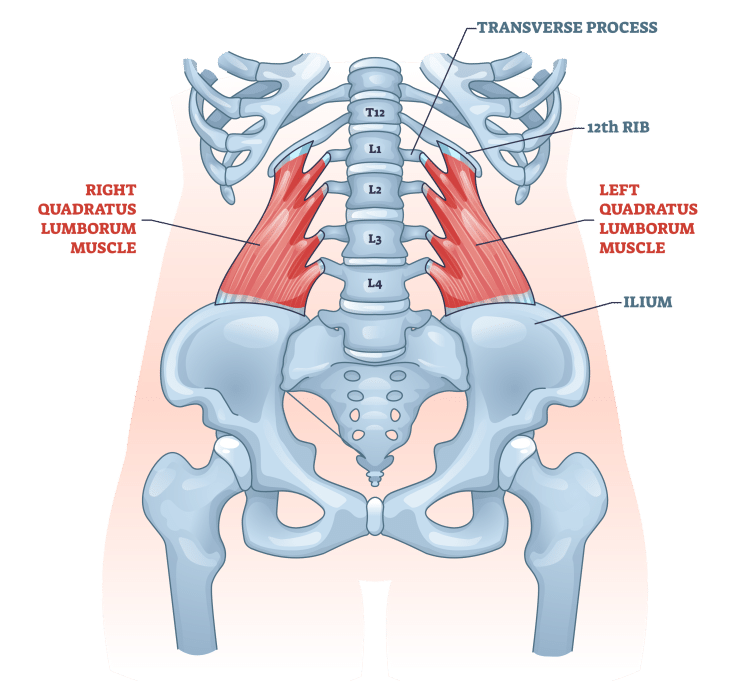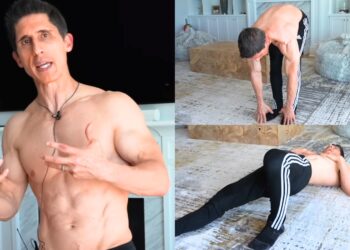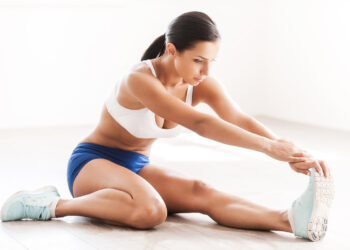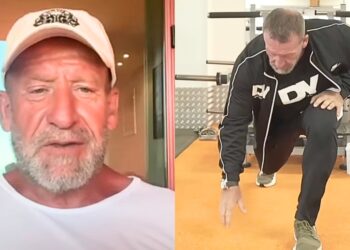When it comes to core and lower back training, most people focus on the well-known muscles, like the rectus abdominis, obliques, transverse abdominis, and erector spinae. Exercisers often use carefully chosen exercises to target these muscles.
However, delve a little deeper, and you’ll find many other muscles that are every bit as important. While you usually can’t see these muscles, they work in the background, providing aid and support.
One such muscle is the quadratus lumborum (QL). It is a pair of muscles in the posterior abdominal wall that run from the pelvis to the last rib on either side of the spine. They are the deepest abdominal muscles and are often called back muscles.
The QL helps stabilize the lumbar area, tilt the pelvis laterally, and extend the lumbar vertebrae. It also helps with breathing by fixing the 12th rib during inspiration, making it easier for the diaphragm to contract.
In this article, we dive into the role of the quadratus lumborum muscle and reveal the best stretching and strengthening exercises for this unsung hero of the lower back.
Level Up Your Fitness: Join our 💪 strong community in Fitness Volt Newsletter. Get daily inspiration, expert-backed workouts, nutrition tips, the latest in strength sports, and the support you need to reach your goals. Subscribe for free! Recent Updates: On May 28, 2024, Fitness Volt’s Senior Editor, Vidur Saini (American Council on Exercise-CPT), updated the article and added actionable expert tips to improve the reader experience.
7 Best Quadratus Lumborum Stretches
Do you feel like you’re being pulled sideways? Do you have pain in one side of your lower back? Are your hips uneven heights? If so, your QL could be tight. Use these stretches to restore your QL to its ideal resting length.
1. Standing QL stretch
| Sets & Reps | Target Muscles |
| Hold 30 sec. | Quadratus Lumborum (QL), latissimus dorsi, obliques, erector spinae, rectus abdominis |
The standing QL stretch is the most basic way to lengthen your quadratus lumborum. Requiring no equipment and minimal space, it’s the ideal stretch for home exercisers. You can also do this exercise after long periods of sitting to release any accumulated QL muscle tension.
“Engage your core during the stretch to create oppositional tension, deepening the stretch and activating the QL for better control,” recommends Saini.
Steps:
- Standing tall, cross your left foot over your right.
- Raise your left arm above your head.
- Lean your upper body over to the side, gently pushing your hips in the opposite direction to intensify the stretch.
- Hold for 30-60 seconds, and then relax.
- Repeat on the opposite side.
Benefits:
- An easy exercise to learn.
- Very spine-friendly.
- Provides a welcome lat stretch as well as elongating your QL muscle.
Coach Tips:
- Note any left-to-right flexibility imbalances and spend more time on the side that feels tightest.
- Keep your hips and shoulders square to maximize the effect of this stretch.
- You can also do this exercise standing next to a wall for support:
2. Gate pose
| Sets & Reps | Target Muscles |
| Hold 30 sec. | Hip flexors, QL, inner thighs, groin, lats, obliques |
This yoga exercise effectively stretches and relaxes all the muscles on one side of your body. Because there are two sets of QL muscles, it’s quite likely that you will find that one side is tighter than the other. If this is the case, spend more time stretching the side that feels most restricted.
Saini suggests actively pressing the top of your foot into the floor and extending your opposite arm overhead to enhance the stretch in your hip flexors and QL simultaneously.
Steps:
- Kneel down with your torso upright and shoulders down and back.
- Move one foot out and away to the side so your leg is straight.
- Engage your core and glutes.
- Next, slide your hand down your outstretched leg while simultaneously raising your other arm above your head.
- Lean over as far as is comfortable, taking care not to twist your shoulders or hips.
- Hold this position for 30-60 seconds, and then slowly relax.
- Swap sides and repeat.
Benefits:
- A very comfortable stretch.
- Easy to modify based on your current flexibility level.
- Quite relaxing and an excellent way to ease tension in your lower back and hips.
Coach Tips:
- Kneel on a folded mat for comfort.
- Increase the stretch as you exhale and feel your muscles relaxing.
- Gently ease your open armpit backward to deepen the stretch.
3. Triangle pose
| Sets & Reps | Target Muscles |
| Hold 30 sec. | Hamstrings, QL, shoulders, lats, adductors |
The triangle pose is another yoga stretch that involves multiple lateral chain muscles, including your QL. The advantage of this pose is that you do it standing, which leads to a deeper quadratus lumborum stretch. However, it’s also a more challenging exercise, so make sure you master the gate pose before trying it.
Saini prescribes slightly rotating your torso upwards to engage your obliques and deepen the lateral flexion of your spine, targeting the QL more directly.
Steps:
- Stand with your feet slightly wider than shoulder-width apart.
- Your right foot should face forward, while your left foot should be turned out at a slight angle.
- Raise your arms so they’re parallel to the floor, palms facing down.
- Hinge at your right hip and lower your right hand down your right leg.
- Simultaneously extend your left arm up toward the ceiling.
- Hold this position for 30-60 seconds.
- Switch sides and repeat.
Benefits:
- Provides a deep stretch for your QL and other waist and lower back muscles.
- Good for developing full-body positional awareness and balance.
Coach Tips:
- Experiment with the width of your stance to see what feels most comfortable.
- Place your lowermost hand on a raised surface, i.e., a yoga block, to take the stress off your lower back.
- Do this stretch on a non-slip surface, preferably barefoot, for stability and safety.
4. Seated QL stretch
| Sets & Reps | Equipment Needed | Target Muscles |
| Hold 30 sec. | Chair or bench | QL, lats, obliques, erector spinae, rectus abdominis |
Muscle tightness can strike at any time, but it’s most often caused by prolonged sitting. Standing up and stretching is not always convenient. The good news is that you can stretch your QL without leaving your desk.
“Exhale sharply as you lean to one side and use your breath to achieve a deeper stretch in the target muscles,” says Saini.
Steps:
- Sit on the edge of your chair with your legs bent to 90 degrees, your shins vertical, and your feet planted firmly on the ground. Get into a good, upright posture.
- Raise your right arm above your head and gently lean over to the left.
- Keep both sides of your butt on your chair.
- Hold for 30-60 seconds, and then swap sides.
Benefits:
- An excellent exercise for office workers.
- Ideal for beginners.
- An easy exercise for those with less mobility, e.g., seniors or chair-bound folks.
Coach Tips:
- This exercise works best on a chair without wheels.
- You can also do this exercise while sitting on a bench or stool.
- Sit on the floor with your legs crossed if you wish:
5. Child’s pose
| Sets & Reps | Target Muscles |
| Hold 30-60 sec. | QL, lower back, shoulders, neck, ankles, lats, glutes |
Child’s pose gently eases your spine into a flexed position, stretching your QL and other lower back muscles. This exercise is excellent for releasing tension from your posterior chain. It is ideal for people with mild lower back tightness or pain. A few minutes in a child’s pose is a great way to cool down after your workout.
Saini urges pressing your hands into the floor while drawing your hips back to create gentle traction through your spine and relieve lower back tension.
Steps:
- Kneel on all fours with your arms straight and shoulders above your hands. Your knees should be below your hips.
- Ease your butt back and sit on your heels.
- Lower your chest down toward the floor while keeping your arms extended in front of you.
- Remain in this position for the recommended time, going deeper as you feel your muscles relax.
- Walk your fingers further away from you to deepen the stretch. You can also place your hands on yoga blocks.
Benefits:
- A gentle stretch for your QL and lower back.
- A very relaxing, calming exercise.
- An ideal exercise for cooldowns.
Coach Tips:
- Kneel on a folded mat for comfort.
- Breathe slowly through your nose to maximize relaxation.
- Experiment with different knee positions to find what’s most comfortable.
6. Knees-to-chest stretch
| Sets & Reps | Target Muscles |
| Hold 30 sec. (10-15 reps) | QL, low back, glutes, hamstrings, lats |
The knees-to-chest exercise gently stretches your QL and other lower back muscles. Using your arms means you can increase the depth of the stretch as you feel your muscles start to relax.
“Gently rock side to side as you hug your knees to improve your lower back and hip ROM,” Saini says.
Steps:
- Lie on your back with your legs bent and feet close to your butt.
- Lift your legs and hold on to the backs of your thighs.
- Gently pull your knees toward your chest.
- Hold for 30-60 seconds, and then relax.
Benefits:
- A gentle, relaxing stretch.
- An ideal stretch for deconditioned exercisers.
- Excellent for easing lower back tension and stress.
Coach Tips:
- Keep your shoulders and upper back on the floor.
- Rest your head on a pillow or yoga block for comfort.
- You can also do this exercise by lifting one leg at a time.
7. Dynamic standing QL stretch
| Sets & Reps | Target Muscles |
| 30-60 sec. | Quadratus Lumborum (QL), erector spinae, rectus abdominis, abductors |
Static stretches are great for easing muscle tension and increasing flexibility. Still, they tend to put your muscles to sleep and reduce contractility. As such, static stretches are ideal for cooldowns but less useful for warm-ups. This dynamic stretch won’t deactivate your muscles and is an excellent way to prepare your QL for your upcoming workout.
Steps:
- Stand with your feet about shoulder-width apart, knees slightly bent. Hold your arms down by your sides.
- Without twisting your hips or shoulders, lean to the left and stretch your hand down the outside of your leg.
- Stand upright and repeat for 10-15 reps.
- Switch sides and do the same number of reps on the right.
Benefits:
- An excellent warm-up exercise.
- Good for mobilizing your lower back before more intense activities.
- An easy exercise to learn, making it ideal for novices.
Coach Tips:
- Keep your knees slightly bent throughout.
- Take care not to twist your hips or shoulders.
- You can also do this exercise in an alternating fashion.
7 Best Quadratus Lumborum Strengthening Exercises
Weak quadratus lumborum muscles can increase your risk of back pain and injury. You need strong QLs to stabilize your lumber spine and prevent unwanted lateral movements.
While most people should train both sides of their QL, you may find that one side is weaker than the other. In this case, do an extra few reps or sets for the weaker side so it can catch up with the stronger side.
1. Bird dog
| Sets & Reps | Target Muscles |
| 3 x 10-15 | QL, core, back extensors, glutes, hamstrings, deltoids |
Bird dogs are a useful exercise that works your glutes, core, shoulders, and upper back. It’s also an effective quadratus lumborum strengthener. During this exercise, you must use your QL to stabilize your lumbar spine, which is one of its most critical functions.
Saini recommends thinking about balancing a cup of water on your lower back to promote stability and ensure proper spinal alignment throughout the exercise.
Steps:
- Kneel on all fours with your arms straight and shoulders above your hands. Your knees should be below your hips. Brace your core.
- Extend one arm forward and your opposite leg backward until they’re parallel to the floor.
- Return to the starting position and repeat on the other side.
- Alternate arms/legs for a desired number of reps.
Benefits:
- A very spine-friendly exercise.
- Teaches you how to brace your core while moving your arms and legs.
- A great way to warm up before more demanding activities.
Coach Tips:
- Kneel on a folded mat for comfort.
- Take care not to arch your lower back, as doing so increases your risk of injury.
- Keep your core braced throughout.
2. 45-degree back extensions
| Sets & Reps | Equipment Needed | Target Muscles |
| 3 x 10-12 | Back extension machine | Erector spinae, QL, glutes, hamstrings |
This exercise provides a great way to overload your lower back and QL to make them stronger. However, keep your spine in a neutral position to avoid injury, i.e., do not allow it to round. 45-degree back extensions are also an awesome glute and hamstring builder.
Squeeze your glutes at the top of each rep to activate the posterior chain and boost spinal stability, recommends Saini.
Level Up Your Fitness: Join our 💪 strong community in Fitness Volt Newsletter. Get daily inspiration, expert-backed workouts, nutrition tips, the latest in strength sports, and the support you need to reach your goals. Subscribe for free!
Steps:
- Climb aboard the 45-degree back extension machine. Place your hips against the leg pad and your feet on the footplate. Bend your knees slightly.
- Lean as far forward as your flexibility allows and without rounding your lower back.
- Push your hips forward and raise your upper body up so your shoulders, hips, and feet form a straight line.
- That’s one rep.
Benefits:
- An effective way to overload your lower back muscles.
- A very accessible exercise as most gyms have a 45-degree back extension machine.
- A proven glute and lower back developer.
Coach Tips:
- Make this exercise harder by bolding a barbell in your hands or a weight plate across your chest.
- You can also do this leg using one leg at a time to increase the overload on your glutes and hamstrings.
- You can also do this exercise with your hips resting on a stability ball if you don’t have access to a back extension machine.
3. Side plank
| Sets & Reps | Target Muscles |
| 3 x 30-60 sec. | Obliques, QL, erector spinae, rectus abdominis, deltoids, hip abductors |
Everyone knows that side planks work the obliques. But they’re also an excellent exercise for your quadratus lumborum. Best of all, because they’re isometric or static, they put very little stress on your spine, so they’re ideal for back pain sufferers.
Saini suggests elevating your top leg and performing a slow, controlled leg raise to further engage your QL.
Steps:
- Lie on your side and rest on your lowermost forearm and elbow. Brace your core.
- Lift your hips off the floor so your body is straight.
- Hold this position for the required duration.
- Lower your hips to the floor, roll over, and repeat on the other side.
Benefits:
- A very lower-back-friendly core exercise.
- Good for increasing lateral stability and strength.
- Do this exercise anywhere and anytime, as no equipment is required.
Coach Tips:
- Do not hold your breath during this exercise.
- Rest your elbow/forearm on a folded exercise mat or foam pad for comfort.
- Push your hips up toward the ceiling to maximally engage your QL and obliques.
4. Dumbbell side bend
| Sets & Reps | Equipment Needed | Target Muscles |
| 3 x 10-12 | Dumbbells | Obliques, QL, rectus abdominis, erector spinae, forearms |
The great thing about dumbbell side bends is that you can increase or decrease the weight to suit your fitness and how many reps you want to do. Use light weights for high reps to improve your endurance or heavy weights for low reps to build strength.
Saini recommends leaning slightly forward before initiating the side bend to pre-stretch your QL and create a larger ROM during the movement.
Steps:
- Hold a dumbbell in one hand, arm down by your side.
- Stand with your feet shoulder-width apart, knees slightly bent. Brace your core.
- Lean sideways and lower the dumbbell down the outside of your leg.
- Stand up straight and repeat.
- Do the same number of reps on both sides.
Benefits:
- An excellent way to overload your lateral chain muscles.
- An accessible exercise as all you need is a single dumbbell.
- A great exercise for building more muscular abs, a tighter waist, and a stronger lower back.
Coach Tips:
- Do not use two dumbbells, as doing so make the exercise much less effective.
- Keep your hips and shoulders square throughout.
- Use lifting straps if your grip fatigues before your core.
5. Single-arm farmer’s walk
| Sets & Reps | Equipment Needed | Target Muscles |
| 3 x 20-30m | Dumbbell/Kettlebell | Core, grip, shoulders, traps, QL, obliques, rectus abdominis |
Farmer’s walks are a popular conditioning exercise. It’s also one of the events often contested in strongman competitions. However, when done with a single dumbbell or kettlebell, the farmer’s walk is also a tremendous quadratus lumborum exercise. Carrying an offset load forces you to use your QL to stabilize your lumber spine. Think of single-arm farmer’s walks as a moving side plank.
Steps:
- Stand side-on to a dumbbell or kettlebell.
- Squat down and grab the weight with the closest hand.
- Pull your shoulders down and back, and brace your core.
- Stand up straight and then go for a walk around your training area.
- Continue for the desired duration or until your grip starts to fail.
- Lower the weight to the floor, swap sides, and repeat.
Benefits:
- A highly functional exercise.
- A great way to build a stronger grip and core.
- An excellent calorie burner and cardio finisher.
Coach Tips:
- Keep your hips and shoulders level throughout your set.
- Do this exercise with any heavy implement, including a barbell.
- You can also do this exercise with your weight above your head, known as the waiter’s walk.
6. Kettlebell suitcase deadlift
| Sets & Reps | Equipment Needed | Target Muscles |
| 3 x 8-12 | Kettlebell | Hamstrings, glutes, lower back, QL, forearms, traps |
No space to do farmer’s walks? I hear you! The good news is that you can get all the benefits of farmer’s walks without taking a single step. Suitcase deadlifts work the same way, but you do them on the spot. This is an ideal exercise for anyone who works out in a small gym.
“Instead of pulling the weight up, focus on pushing the floor away with your feet to activate your glutes and posterior chain muscles,” cues Saini.
Steps:
- Stand side-on to a kettlebell. Your feet should be roughly shoulder-width apart.
- Squat down and grab your weight with the closest hand. Pull your shoulders down and back, and brace your core.
- Drive your feet into the floor and stand up, taking care not to round your lower back or allow your hips to rise faster than your shoulders. Do not lean to the side or twist your hips or shoulders.
- Lower the weight back to the floor, reset your core, and repeat.
- Continue for the desired number of reps, and then swap sides.
Benefits:
- A very functional core, forearm, and lower body exercise.
- A great way to fix left-to-right strength imbalances.
- A home gym-friendly alternative to conventional deadlifts.
Coach Tips:
- Use gym chalk for a better grip.
- You can also do this exercise with a dumbbell or barbell.
- Place your kettlebell on a raised platform if you find it hard to bend over and reach the floor without rounding your lower back.
7. Medicine ball rotational slam
| Sets & Reps | Equipment Needed | Target Muscles |
| 3 x 8-10 | Medicine ball | Obliques, core, shoulders, QL, lats, deltoids |
Most quadratus lumborum exercises are performed slowly and smoothly. While that’s fine for building endurance and strength, it’s less useful for developing muscle power, which is your ability to generate force quickly and is an integral part of most sports. Power training should be part of your workouts if you’re an athlete. Medicine ball rotational slams are one way to build a more powerful QL.
Steps:
- Stand with your feet shoulder-width apart, knees slightly bent. Hold a medicine ball in front of you. Brace your core and set your shoulders.
- Raise your arms above your head and, using a twisting motion, throw the ball down at the floor to the outside of one foot.
- Catch the ball as it bounces, lift it up, and hurl it down to the other side.
- Continue for the desired number of reps.
Benefits:
- An explosive exercise for building core rotational power.
- A fun, satisfying workout.
- An excellent stress reliever.
Coach Tips:
- Do not use a gel-filled medicine ball, as they’re prone to splitting.
- Rise up onto your toes and put your entire body into each throw.
- Wind up each throw using a circular arm action to increase core and QL engagement.
Quadratus Lumborum Anatomy

The quadratus lumborum, or QL for short, is a deep back muscle. That means it lies beneath other muscles, including the lats and paraspinal muscles. QL is a large, flat muscle located between the iliac crest of your upper pelvis and your 12th (lowermost) ribs.
There are two QL muscles – left and right – that can work independently as well as together.
The functions of the quadratus lumborum are:
- Lateral flexion of the spine – bending sideways.
- Extension of the spine – bending backward.
- Stabilizing the spine – preventing unwanted movement.
QL tightness can affect your lower back and pull your spine sideways, putting undue stress on your hips, lumbar spine, and intervertebral disks. In contrast, a weak QL can reduce lumbar spine and hip complex stability, increasing your risk of injury.
FAQs
1. How do I isolate my QL muscle?
Whether you are stretching or strengthening, you cannot isolate the quadratus lumborum. Invariably, it works in conjunction with several other muscles, including your obliques, rectus abdominis, and erector spinae.
So, when you try to stretch or strengthen your QLs, you’ll also be working other muscles. This is no bad thing, as that’s how the QL works in nature — with other muscles and never alone.
2. How long should I hold QL stretches for?
The time you hold a stretch depends on what you are trying to achieve. For example, if you are stretching to maintain your current flexibility, you only need to hold a stretch for 15-20 seconds. This should be enough to prevent your flexibility from decreasing.
However, if you want to improve your flexibility, you need to hold your stretches for longer, usually 30-60 seconds. During this time, you should try to increase the depth of your stretch as you feel your muscles relax.
You don’t need to choose between these two durations. You may have one QL tighter than the other, so you could do short maintenance stretches on one side and longer developmental stretches on the other to fix the imbalance.
3. Will training my QL make my waist thicker?
The quadratus lumborum is a relatively long, slender muscle. As such, while training it will produce some hypertrophy or growth, it won’t make your waist thicker. If anything, a better-developed QL with give you a tighter waist.
Too much body fat is a far more common reason for having a thick waist. Too much muscle mass around the midsection is rarely a problem.
4. Some of these QL exercises hurt my back – what gives?
The quadratus lumborum muscles are located on the sides of your lower back. As such, overstretching can cause lower back pain. Also, exercises that affect your QL invariably involve your lower back.
If any of these exercises hurt, you should stop immediately, check that you are doing them correctly, and gently try again. Should the pain persist, skip the movement that bothers you can try something else.
Finally, if you’re still experiencing QL or lower back pain, get it checked out by a medical professional, as it could require treatment. Never train through pain, as that will probably make it worse.
5. Do I really need to stretch or strengthen my QL?
When it comes to prehab and rehab stretching and strengthening, you should choose your exercises based on your needs. For example, if your QL feels tight, limits your lateral movements, or causes pain, stretching could help. In contrast, if you lack lateral stability, you probably need to strengthen your QL.
However, if you have no such issues, you may not need to spend time on your QL. It’s probably getting sufficient indirect work from the rest of the exercises in your training program.
Wrapping Up
While the quadratus lumborum is a lesser-known back muscle, it’s still important. A weak QL can cause lumbar instability and dysfunction. In contrast, a tight QL can affect your posture and cause pain.
Thankfully, stretching and strengthening the QL is relatively simple, and the exercises for both of these purposes are simple and easy to perform. Many can be done at home as they require no special equipment.
But before you head off to stretch or strengthen your QL, you need to understand that it may not need any extra work. If you have no noticeable tightness or weakness in this area, your QL is probably strong and flexible enough.
That said, if you do need to pay more attention to your quadratus lumborum, you now know the best exercises to use.
References
- Phillips S, Mercer S, Bogduk N. Anatomy and biomechanics of quadratus lumborum. Proc Inst Mech Eng H. 2008 Feb;222(2):151-9. doi: 10.1243/09544119JEIM266. PMID: 18441751. https://pubmed.ncbi.nlm.nih.gov/18441751/
- Xu C, Fu Z, Wang X. Effect of Transversus abdominis muscle training on pressure-pain threshold in patients with chronic low Back pain. BMC Sports Sci Med Rehabil. 2021 Apr 1;13(1):35. doi: 10.1186/s13102-021-00262-8. PMID: 33794983; PMCID: PMC8017650. https://pubmed.ncbi.nlm.nih.gov/33794983/









This is a great reference!! Very well done and much appreciated!!